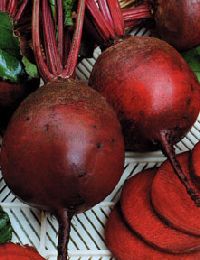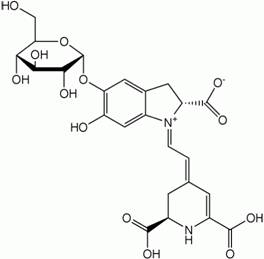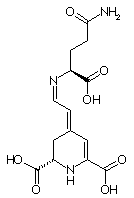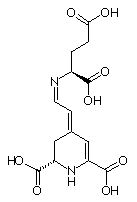Beetroot colours (betalains)
The beet (Beta vulgaris) is a flowering plant in the family Amaranthaceae, native to western and southern Europe, from southern Sweden and the British Isles south to the Mediterranean Sea. It is important because of its cultivated varieties, fodder beet, beetroot and the sugar-producing sugar beet. The beetroot is a red coloured tuber that is cooked like potatoes and eaten as a vegetable. It is essential in the famous Russian and East European red soup (Russian : borscht). Pickled beetroot slices are often used in salads and as decorations.

Figure 1. Beetroot (Source)
The colour of beetroots is caused by the colours, betanin and vulgaxantin. Beetroot extract is used as a food colour and has E-number E162.
Structure
Both betanin and vulgaxanthin belong to the betalain-group of colours. These colours do not only exist in beetroot, but also in several other plants and mushrooms, none of these are important as foods, with the exception of the prickly pear cactus (Opuntia ficus-indica), which has low concentrations of the colour in the edible fruits.
Betalains are classified on their structure and divided into two groups; betacyanins and betaxanthins, with red-purple and yellow colours respectively. More than 50 betalains have been described.
In beetroot the main betacyanin is betanin (fig 2) and the main betaxanthins are vulgaxantin I and vulgaxanthin II (fig 3). The latter only differ in one side group of the molecule.

Figure 2 : Betanin (Source)


Figure 3 : Vulgaxanthin I (left) and II (right) (Source)
Use
Beetroot extract or –pulp has been used to colour food for many centuries, but the beetroot itself always was an ingredient. The use of betalains as separate food colours date from the early 20 th century, when in the US pokeberry (Phytolacca americana) juice was added to wine to enhance the colour. Nowadays only beetroot extract has been approved as a colour in most countries.
All betalains are water soluble, which limits the use. Betalains are stable between pH 3,5 and 7,0 which covers nearly all foods, with a maximum colour stability at pH 5.5. Betanin is susceptible towards light and temperature, which limits the use to fresh foods, foods packed under modified atmosphere, or foods that undergo no heat treatment. It is mainly used in frozen products (ice cream, yoghurt).
Dry betanin is more stable and it is used as a colour in instant foods powdered soft drinks. It is also stable in high sugar conditions and can thus be used in candies and fruit gels and fillings.
References
- Lauro, G.J. and Francis, F. J. (Eds) Natural Food colours, Science and technology. IFT Basic Symposium Series 14, Marcel Dekker, 2000.
- Delgado-Vargas, F. and Paredes-López, O. (Eds): Natural colorants for food and nutraceutical uses. CRC Press, 2003.
 手機版
手機版








